I have written a separate post about how I visited the Mentawai tribes in Siberut. For more information on what you can see and do during a 4-day visit and how you can arrange it, see that post.
But since there are so many more interesting things that I learnt about them, I decided to write a separate post on Mentawai culture and religion and other matters relating to the Mentawai people. Here, I will share with you some of the things I learnt from the Mentawai themselves when I was living with them for a few days.
1. The plight of the Mentawai
Mentawai culture is very different from that found in neighbouring Sumatra or anywhere else in the region. They have lived a secluded life for centuries before the Dutch “discovered” them – what a terrible word to use for “wanting to subjugate someone”… But the really hard times came between the 1970s and the 1990s, when the Indonesian government wanted to “modernise” them. This meant that the police raided their homes, and told them what they may and may not do, told them what they may or may not believe, and how they may and how they may not live their own lives.
This included religion in the first place. They were forced to choose from the five “official” religions of Indonesia: Islam, Buddhism, protestant Christianity, catholic Christianity and Hinduism. Why they regard the two christian denominations two separate religions remains a mystery for me – but then, I only have a Master’s degree in the study of religion… But for more about religion among the Mentawai, see the separate section below.
Tooth sharpening is a tradition in several communities around the world, including the Mentawai. At least it used to be. But then came the Indonesian government, who banned it completely. During my trip at the end of 2019, I didn’t see any women with sharpened teeth. (For more info about tooth sharpening, see the this Wikipedia article.)
When the police came, they also forcibly cut local men’s long hair, and even burnt it on the spot – don’t ask me why. They also made it compulsory for them to wear clothes customary among the Indonesians, but the shaman/sikerei continue to wear the traditional loincloth and nothing else even today.
2. The Shaman/Sikerei

The person whom we call shaman in English is called the sikerei in Mentawai. This literally means “that who heals” (kerei = to heal). His main role is to heal people on the one hand, and to serve as a guardian of the balance between the people and nature on the other hand.
To become a shaman you have to instinctively feel the talent/power/inclination for this role. If you do, you talk to your family and your clan, and then you ask an older sikerei to teach you. The process takes a long time. As one the sikerei, Baja Tarason said, you can’t become a sikerei too young: when you are young, you may be overwhelmed with emotions. But to be successful, you have to keep a balance between your emotional and your logical mind. If you don’t, you may very easily make mistakes.
The knowledge they must acquire includes just about everything that could be known about the plants and herbs found in the jungle. Besides this, they must be knowledgeable about Mentawai history, traditions, the spiritual world and related matters.
After the “apprentice” is ready to become a sikerei, he must go through an initiation, which is a ceremony lead by the old shaman. All the clan comes together for this, and there are ceremonial dances and chantings. At this point, the new sikerei does not necessarily have all the tattoos that a sikerei is supposed to have.
When I asked one of the sikerei whether they are respected in the community, he answered: I suppose we are, but you must be modest.
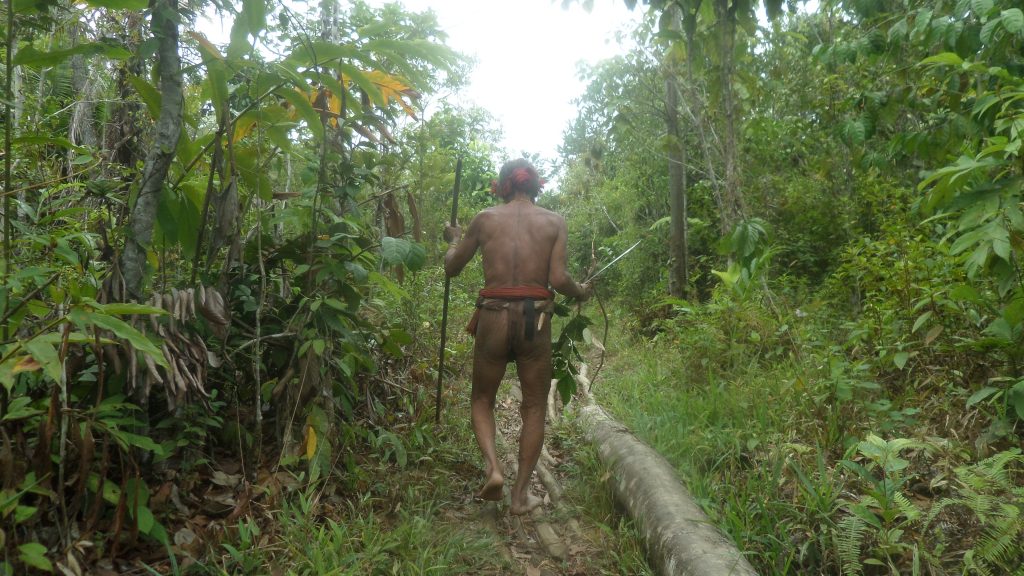
3. Mentawai tattoo
Mentawai tattoo is now world famous among tattoo enthusiasts. There are tattoo makers in the villages, who know their job well to make the tattoos for the shamans, too. They don’t work for free, though – see the info in the post about my visit to the Mentawai villages, where I explain how much it costs.
Mentawai tattoos always have a meaning or significance, they are not purely decorative. This is especially true in the case of the shaman. There are tattoo lines representing the bow and the arrow (highly important tools for the Mentawai), the spiritual world, and even some that serve protective purposes: the ring shaped tattoos on the ankles will protect the Sikerei from the evil meaning spirits that he must expel from the sick person’s body. These spirits may actually hurt the shaman himself when they flee the body – unless of course they are prevented from doing so by the special tattoo.
The shaman can only be a man, but his wife is also expected to wear special tattoos. In every case, women tattoos are different from men tattoos. The sikerei’s wife must also know at least something about healing, and she is regarded a special person by the community.
Young people wear only a few tattoos, and I also learnt, that nowadays they even have patterns that used to be reserved for the sikerei only. Times are changing.
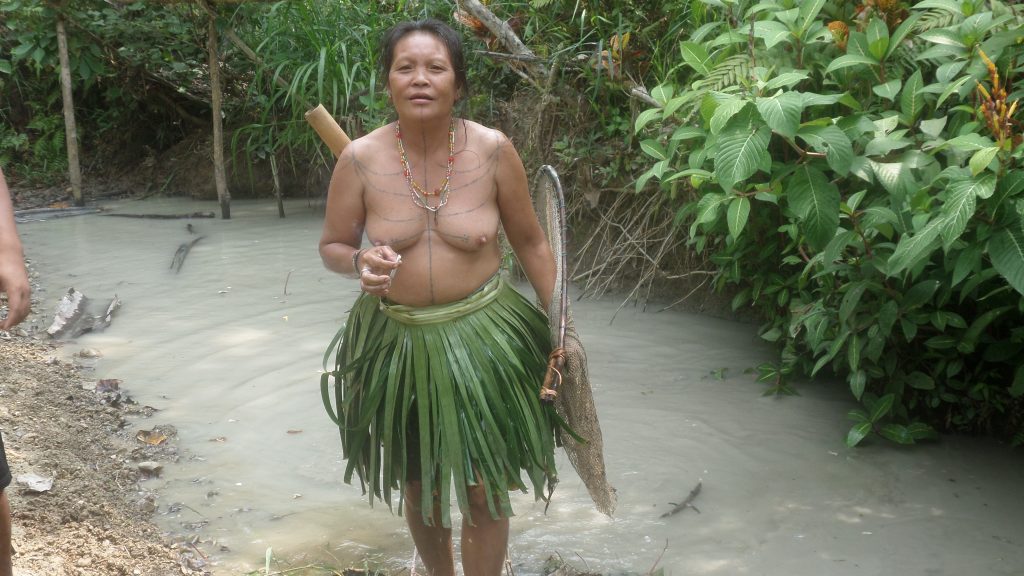
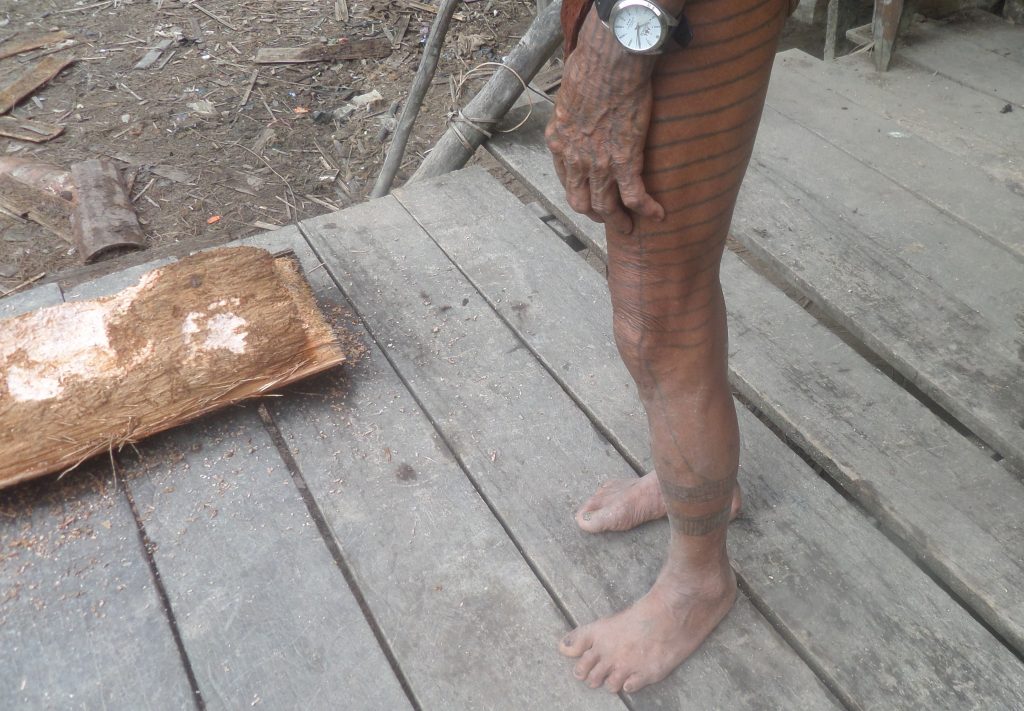

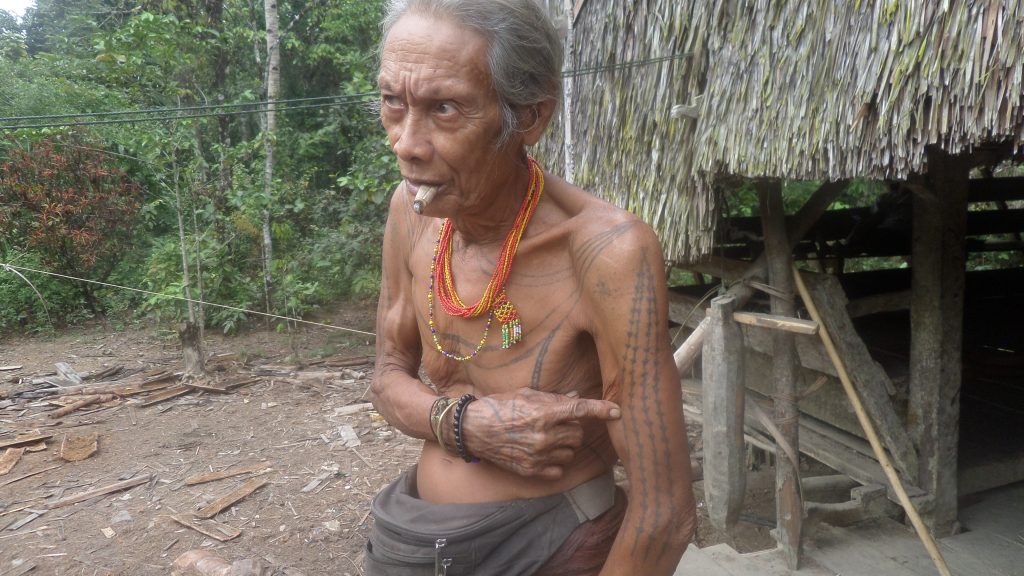

4. The Mentawai house

All the houses that I visited, including the ones in the town on the shore, have a very similar structure and living arrangement. There are no rooms in the modern sense of the word, but the house is usually divided into sections. In some bigger houses, there is one section where only women may sleep at night. In most houses, there are no doors inside the house. At the main entrance, there are huge drop doors that you can lift and drop vertically – at least theoretically. Because in practice, they are never closed, and in fact, they can’t be closed: they keep them lifted up, and they use the space on top of them to store various stuff.
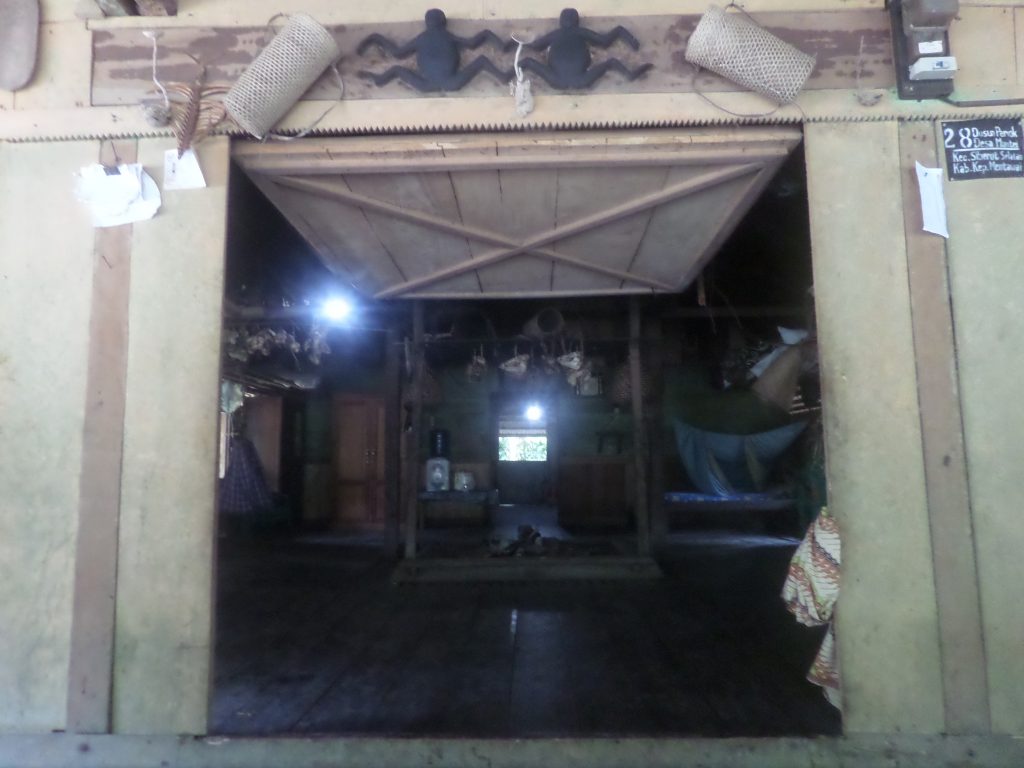
The houses have practically no furniture. I saw no beds, no cupboards or even shelves. The nearest you can get to furniture is the dish racks that I saw in most places, where they keep the dishes – not an awful lot of them though. I don’t believe the Mentawai are like most of us in Europe, who collect just about everything, 99% of which is left unused. Yes, look around your home now, and check how much of the stuff you have is actually used and necessary. (And once we are talking about this, check out my blog post about how I got rid of almost all my things – with tips on how you can do the same if you want to.)
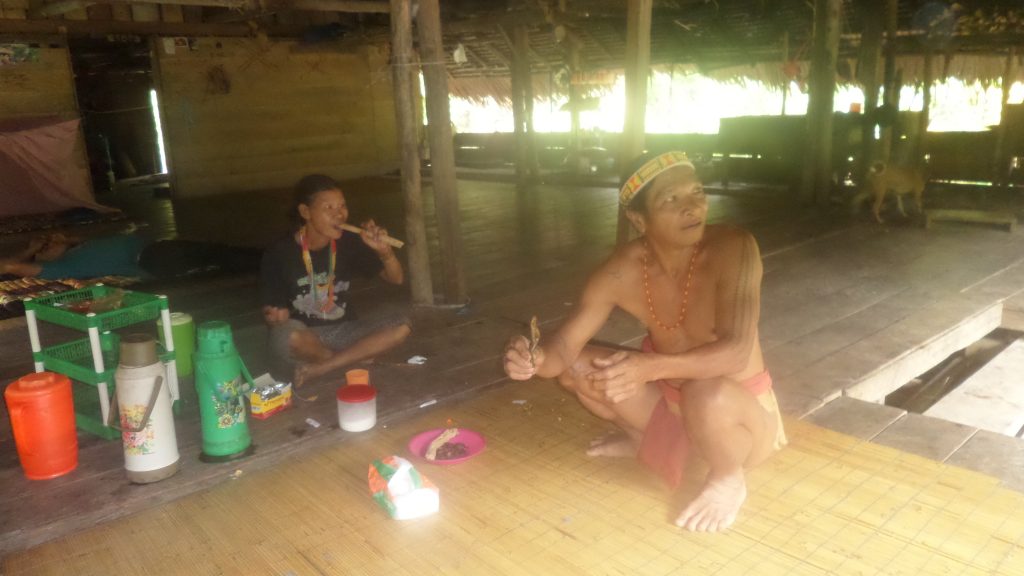
I only had the courage to ask my guide (as opposed to my host family) about sex life. Because if there is no privacy, what do they do if they want to have sex, I asked. “Then they go ahead and do it,” he said. In the privacy of the mosquito net, that is. It is true, that it is pitch dark at night, but sound spreads in all directions regardless of the light conditions, I thought to myself… Yes, the stupid European that I am, just cannot imagine this. Without a drink or two, at least. Talking about which, my guide said the Mentawai do not make their own alcohol, and I didn’t see anyone drinking while I was there.
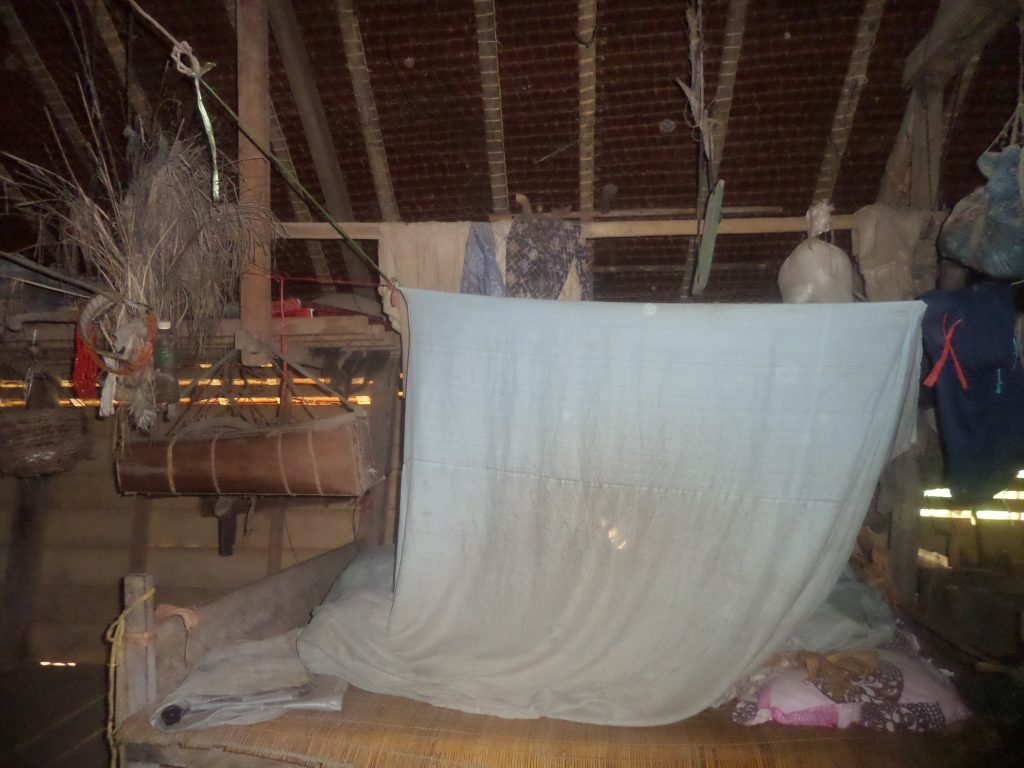
In the middle of the main room (the shaman’s room), there is a fireplace where they cook. In one of the larger houses, I saw several fireplaces. After night falls, they use kerosine lamps, but usually go to bed very early (for me). At about 9, we were already in bed. Since the house has no real walls, and because there are no doors that you could close, it actually feels like you were sleeping in the open air – well, in fact you are! And you hear the jungle noises all night long, plus the pigs walking around grunting occasionally, so some might find it a bit difficult to fall asleep (I sometimes did).
In the house, there are lots of animal skulls hanging from the ceiling or the “doors”. These are the skulls of hunted animals (gibbons and other monkeys, wild boars, deer) and the pigs that they have eaten at bigger celebrations. By putting the skulls up in the house at prominent places, they show respect to the animal’s spirit, which is not only a nice gesture, but also a protective action, because the spirit may otherwise return and do every kind of nasty things to the family.
Besides this, they may also serve the purposes of “showing off” the wealth of the family: the more skulls you are able to display, the wealthier you are.

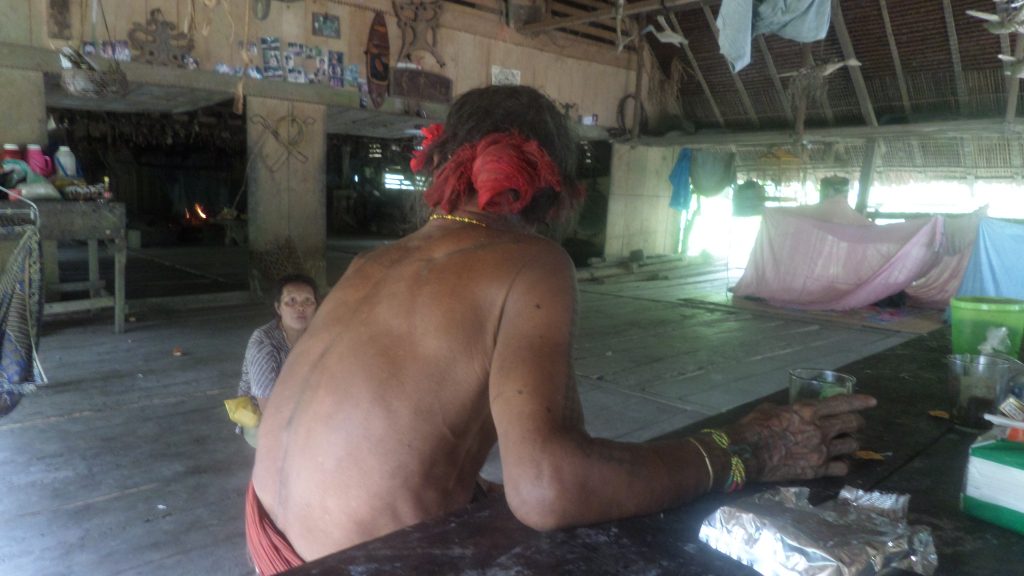
5. Marriage
Earlier, marriages were decided on and arranged solely by the parents. They would discuss the financial and other matters between themselves, and no-one really cared much about what the young couple thought or if they were happy with this arrangement.
Times are changing now. It is quite possible for a young person to choose his or her partner. There are young couples today who met each other at the school, which is 3-4 hours’ walk from the village. But even today, they must request permission from their parents and their whole family or even the clan. This is also important for financial reasons. The boy’s family must pay a huge amount of goods to the girl’s family. I talked to one young husband, who said, with quite a bit of outrage in his voice, that he had to pay 20 pigs, one hectare of sago, 1 ha of durian and 1 ha of coconut plantation, a lot of chickens, in addition to cash, to the girl’s family. He also asked me if in Europe, we have to pay a lot for the girl. When I said we don’t pay at all, he could hardly believe it was free, and jokingly said he should move to Europe then.
The truth is, however, that even if this sounds like an awfully high price to pay for marrying a girl, it is usually paid by the whole clan, or at least several families of the clan, and it goes to the girl’s clan, and not to her family only. Sharing is still highly valued and important in the Mentawai culture.
When the young couple get married, they move to the boy’s family’s house. Times, with this too, are changing though. I have seen one young couple, who built their own tiny house, and they live there with their little baby, separately (though not very far) from their families. They are also starting to get “modernised”. When I was visiting them, the guy showed us their new water purifier gadget – a thing unheard of here in the Mentawai jungle. They usually drink water from the small rivers, which they boil for babies and very young children.
They also had shelves (shelves!!!, can you imagine?) in their house, on which I saw toiletries – another thing you are not likely to see in any of the other houses. Not only that, this young guy had a smartphone and a pair of bluetooth speakers, so we were singing Shakira’s “Waka-waka” together happily.

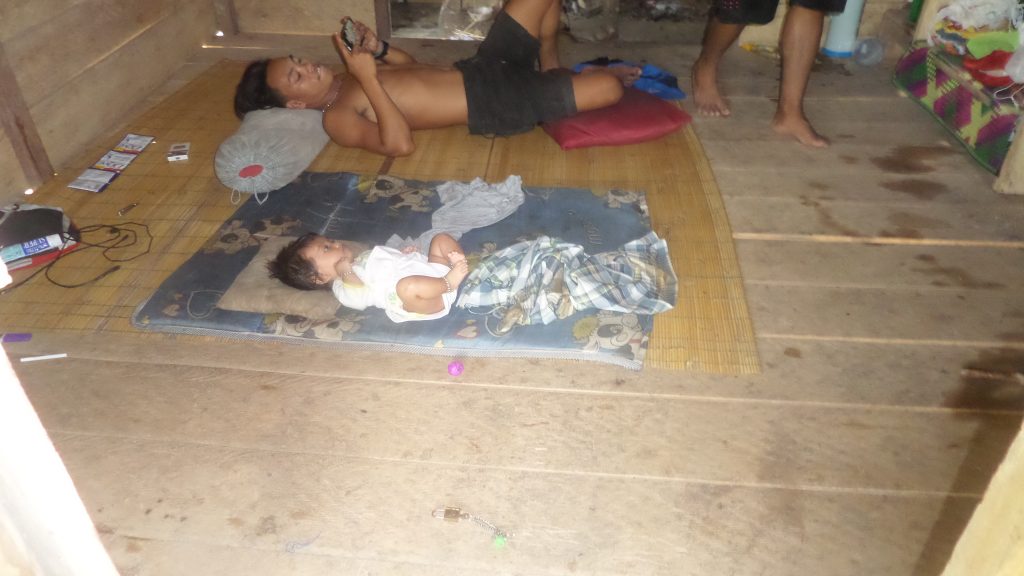
6. How the Mentawai look at religion
As I mentioned above, they Mentawai were forced to choose one of the five religions that are recognised in Indonesia. Most of them chose christianity: protestant in the towns, and catholic in the villages. “But we don’t practice it,” added hastily one of the Mentawai gentleman whom I asked about it.
A lot of them also asked me what my religion was. It was a little difficult to answer them correctly. I am an atheist, a notion they are not likely to be familiar with. I told them simply the truth, this way: “I don’t believe in any of the gods,” which was always received with great appreciation and high fives, by every single Mentawai person. And that is because they don’t believe in any of the gods either! But wait, this doesn’t mean they are atheists in the usual sense of the word.
The Mentawai believe that every living being, including all the animals and all the plants, possess a spirit, in addition to the jungle itself, the earth, the waters and the sky. The spirits may offer you a helping hand, but they may also cause trouble, so you must respect all of them at all times.
This is how it all began:
The world was created by a god, Taika Manua or Taikamanua. Taika means something similar to what we call the universe, while manua means humankind, humanity. But creating the world is all that he did. There are guardian spirits for the air, the trees, the animals, the water and everything around us.
Now there was a time, when a man came down from the sky. His name was Pabete Sabau. He knew everything about healing, about the nature around us, and the balance between man and nature. He was the first sikerei (shaman). Later, there were more and more people, and Pabete Sabau taught everyone how to respect nature and the surroundings, and how to keep the balance, how not to exploit the earth and the jungle and the animals.
People didn’t listen, and they were so greedy that they hunted more than they had to, they used more resources from the jungle than what they needed, and Pabete Sabau thought this was not leading to anything good. So he called together all the animals of the jungle into one place, so that people could not hunt them any more.
After a time, people started to starve, and suffered a lot. So they went to Pabete Sabau and asked him for forgiveness. They regretted their sins, and Pabete Sabau forgave them, so they could hunt and use the jungle and the seas again, but now, very responsibly. And they have been living in harmony with nature ever since, to this very day.
Even today, when a Mentawai man prepares for hunting, he always asks Pabete for permission, pledging to only use and hunt what is necessary. They ask Pabete to bless them and their arrows, so that they could hunt successfully.
What I like the most about this story is that it reverses the usual idea shared by virtually all major religions, according to which there was a golden age, when people were good and happy, but now things are bad, people are bad, life is bad, everything is shit, we are sinners, and damned for all time. Oh, my! Isn’t this just the sickest and most disgusting idea? Don’t we have enough people with psychological problems?! Now the Mentawai think it is the other way around: there was a time when people were bad, when life was hard, but now things are good, people have regretted behaving badly, they have changed, and they live happily in harmony with nature today. Isn’t this just a much healthier and more educational and useful idea, religious or not?
7. Daily life and activities
While I was there, my hosts didn’t have major work to do in the village, but I saw some work activity anyway. First of all, two of the shamans showed me how they plant new trees, how they make loincloth, and I went fishing with two women. But the purpose of these were obviously to show me how they do it, rather than because they were in need of the end products.
However, I also witnessed them doing real work, too. I saw several women making baskets from rattan. Some of these were made for their own use, but one woman was making baskets to sell in the market in the nearest town.
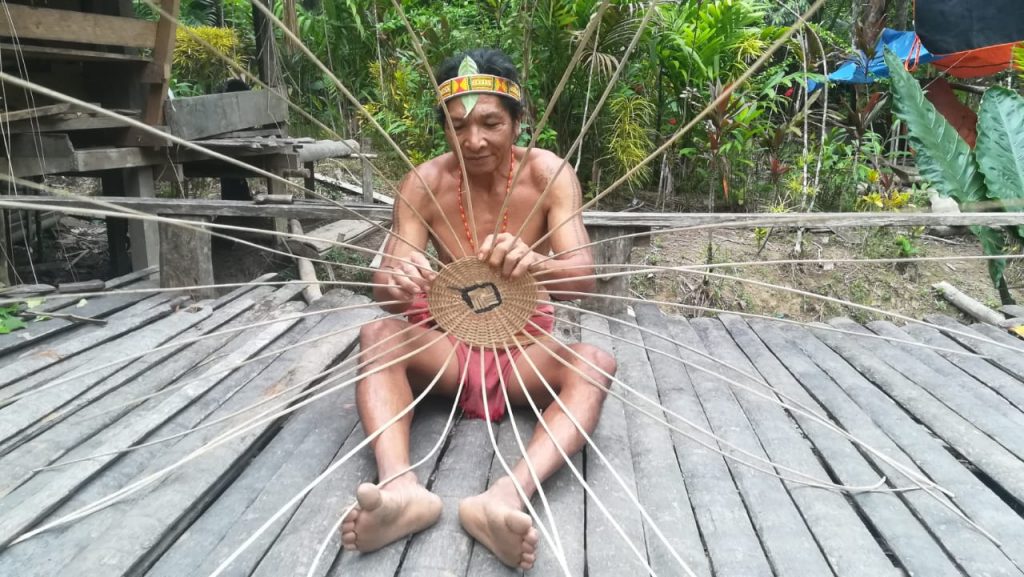

Another income generating activity I saw was drying cocoa beans and betel nuts – these would also end up at the market. They can also sell coconuts and other fruits that they grow locally in the jungle. As for work, I know of one guy who was working in the nearest “real” village as a carpenter.
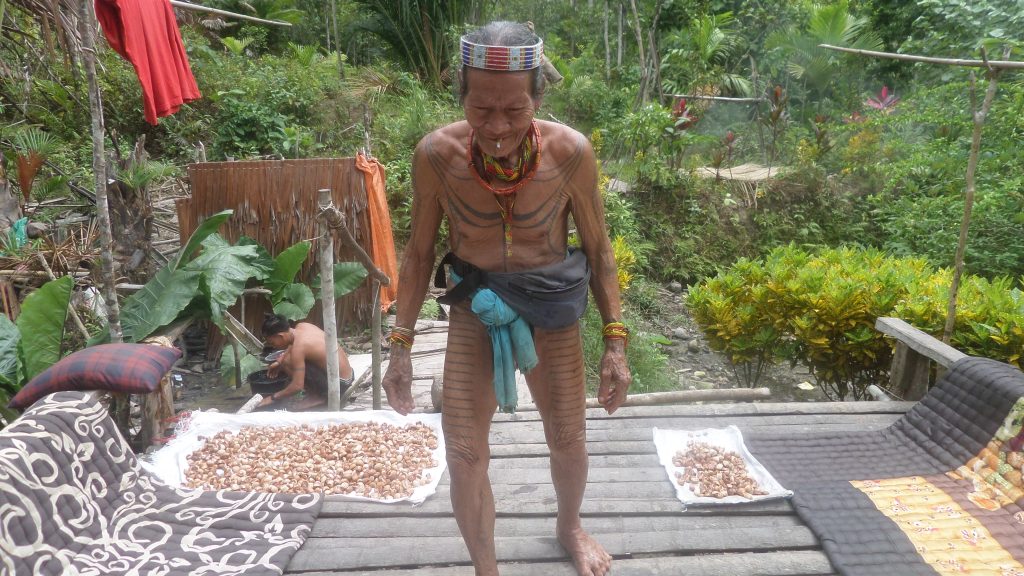
The Mentawai use sago for a lot of purposes: they eat it, they feed it to their animals, they use it for building material, and they also eat the sago grubs that grow inside the tree. They don’t use rice, instead, they make sago flour, and bake it over fire. Meat is a rare delicacy, since it is very expensive. Plus, once you kill a pig or another larger animal, you have to consume it immediately, because they have no fridges or other ways to preserve meat for later use. If they kill a pig, they will invite other families too, but this only happens at celebrations or other special occasions. Vegetables, fish and sago – this is what the menu will include on most days, perhaps with delicacies like the sago grub either alive or fried.
I told my guide at the beginning that there is no way I would taste sago grubs, so I am sure this is why they ever wanted to show me ow they prepare and eat them.

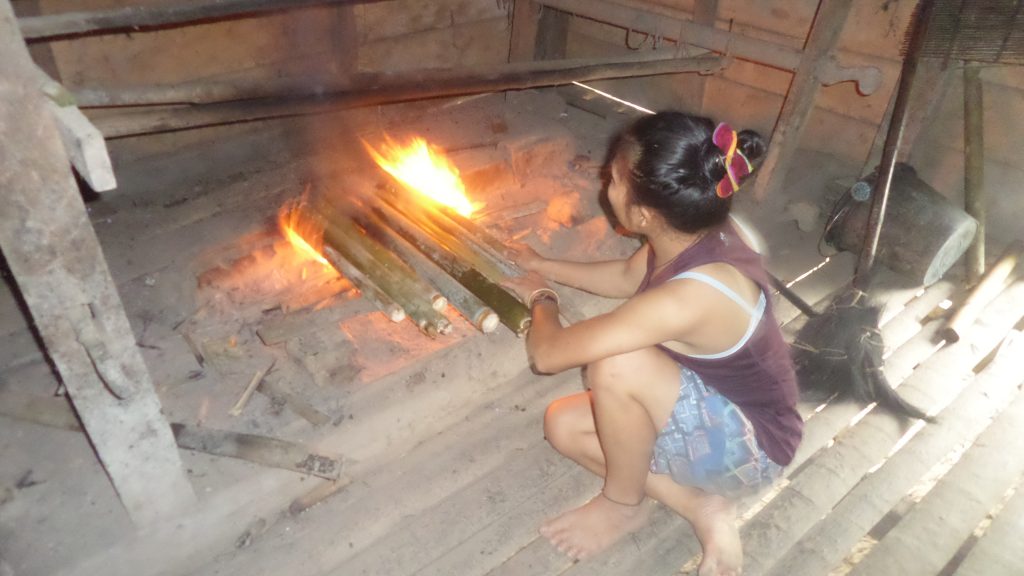
8. Schooling
Schooling is quite problematic. The nearest school (primary and secondary) is in the town, Mailepet, which is accessible by walking and canoo, and it takes about 3 to 4 hours to get there. Keep in mind that in the rainy season, you will have to negotiate in thick mud all along the way. A few year ago, they started offering boarding school possibilities in the town, so children don’t have to spend 6-8 hours walking in mud every day if they want to go to school. You can imagine then, what percentage of school age children will finish school (very low).
One young guy I talked to dropped out of school because he met the tourists, and saw that there is a good opportunity for him in dealing with these foreigners rather than “wasting his time” at school. He finished 5 years of school, and then decided to devote his time to learning about the tourists, and also started to learn English. Today, he can communicate in English quite nicely – all this without a teacher or books. Now it would have been rather awkward if I had started to explain him about the importance of schooling. Especially because now he already sees the fruits of his decision: he is working in tourism now – he prepares food, arranges things, and even explains a few things about the Mentawai to some tourists in English. And he earns money with it!
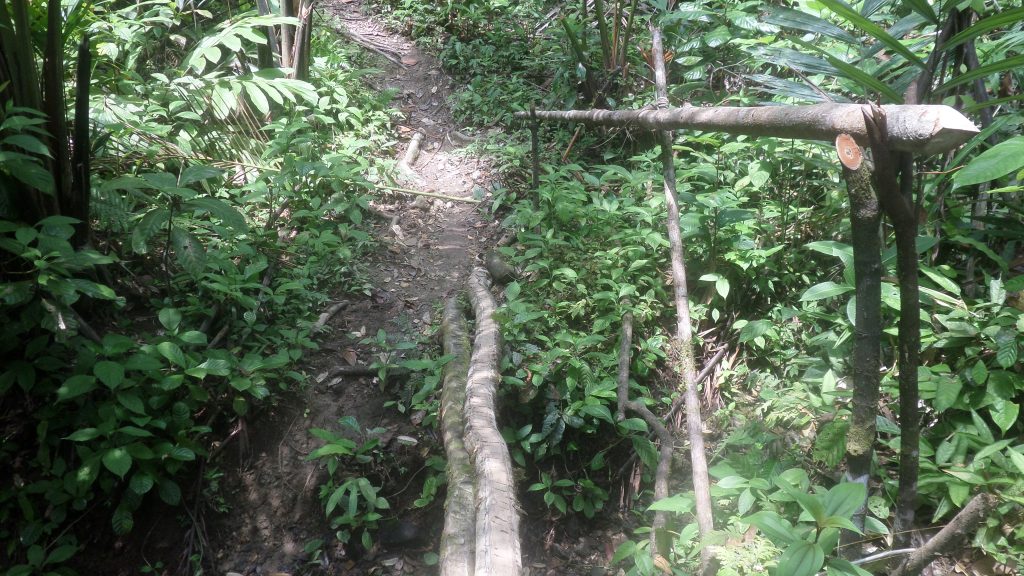

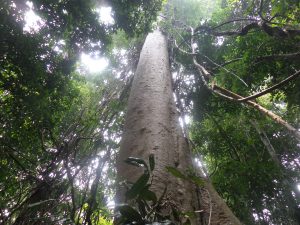
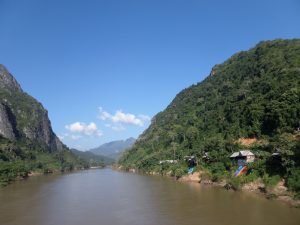

Hey – I really enjoyed this blog post 🙂 Thanks for taking the time to write this out and share so much personal and specific details! I hope to learn and visit here too one day.